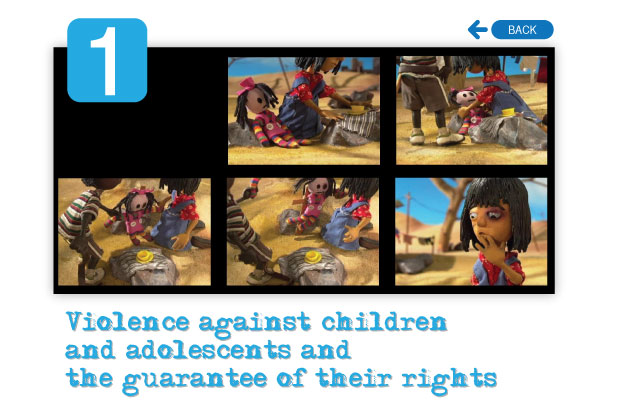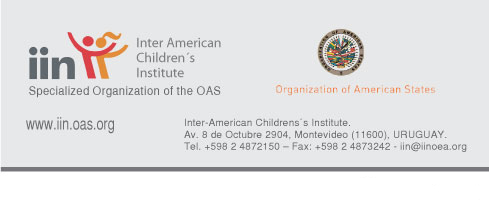| |
What is meant by violence?
Violence is a multidimensional social phenomenon, expressed at all levels and that its eradication is one of the biggest challenges for societies.
In the exercise of reviewing the various definitions of violence, are remarkable two meanings of the word "violent" established by the Royal Spanish Academy, for its simplicity and clarity, namely: a) That acts with force and b) That performs against the regular mode or out of reason and justice. In the first meaning is the use of the word force, that undoubtedly is the most important feature, and in relation to the second meaning is relevant from the point of the juridical, the use of the word "justice" as violence undoubtedly represents its lack.
Additionally, when making specific reference to violence against children and adolescents, it is important to consider, as does the Study of Violence against Children, United Nations (UNVAC), the definitions of violence of the Convention on the Rights of the Child in its Article 19: "all forms of physical or mental violence, injury or abuse, neglect or negligent treatment, maltreatment or exploitation, including sexual abuse” and in addition World Report on Violence and health of the World Health Organization (2002): "The intentional use of physical force or power, threatened or actual, against oneself, another person, or against a group or community, that either results in or has a high likelihood of resulting in injury, death, psychological harm, maldevelopment or deprivation”.
The development of the approach to this matter for many years has converted it nowadays in one of the most important issues for societies and their governments. The ratification of the Convention on the Rights of the Child (CRC) has marked a point of departure from which has been possible to address the issue of violence against children and adolescents with greater clarity and depth.
It exists in our modern societies a greater awareness of the effects that generates violence and thus less social tolerance to its manifestations. For the States is one of the major problems and they have given an important emphasis to the subject, which resulted in public policies and specific legislation to handle this phenomenon.
Advances and Challenges
In terms of public policies and legislation against violence to children and adolescents, the Member States of the Organization of American States (OAS), in general, have important achievements. Once they ratified the CRC, the States, pursuant to many commitments that involves this legal instrument, started a process to promote and disseminate the rights of children and adolescents, which resulted into social change on the collective consciousness regarding the issue of abuse (physical, psychological and sexual) and exploitation. Somehow, this change in consciousness resulted in a significant progress, provided that situations that were not previously perceived as violent are now recognized and confronted.
The social recognition of these "new" situations that violate rights (as is the domestic sexual abuse, labor exploitation, etc.) had as a parallel process the change of legal frameworks, task that was sufficiently large and productive, and which had important changes in institutionality related to the care of children and adolescents. A significant number of this legislative production is to directly protect children and adolescents from different forms of violence.
On the issue of violence related to children and adolescents, there are two issues on which there is already significant progress, but there is still a need for a greater awareness and study. These two issues are: violence among children and adolescents (considering, but not exclusive, bullying) and physical or corporal punishment by parents, guardians, caregivers and educators, among others.
In the case of punishment, its eventual generalized prohibition is considered to be one of the most revealing achievements in relation to the full respect for the dignity of children and adolescents. This practice is so common and of everyday that is unnoticed as the right violation that it is, with the aggravating circumstance that has cultural and customary features that cause a great resistance to its removal. A major progress on this specific topic is represented by the Report of the Inter-American Commission on Human Rights, entitled "Corporal punishment and human rights of children and adolescents".
Similarly, an issue that remains a challenge for the countries of the region is the approach to juvenile criminal law, which undoubtedly is important and complex to address, for its citizenship sensitivity, as is strongly associated with the field of public security.
When legislating on violence in general it is critical to consider that in relation to children and adolescents it is manifested in different areas and therefore the regulatory response to this problem must be general, comprehensive and specific to these areas, since the modalities and consequences are different. These areas are mainly: home, school, street, detention centers and care centers.
Therefore, legislation on violence promulgated must go beyond the mere enunciation of the right not to be victims of violence, as mostly has been done, and thus regulate the matter with a comprehensive public policy with elements of public policies that include the prevention of the phenomenon, detection of situations, protection of victims, handle of situations, victims and perpetrators, criminal reaction in the most serious cases of violence and the post-accompanying.
There are two major challenges -one conceptual and the other institutional - important in relation to violence, the first one refers to the trend in the states of the region to give more importance to the establishment of comprehensive public policies and national plans, in which, when violence is included with specific and effective strategies, positive results will be seen in a medium term. The challenge at the conceptual level refers to the increasingly widespread view that in relation to children and adolescents, violence is to violate any of their rights. This concept is important since it goes beyond the traditional view of violence and in case of widespread and reach consensus as a paradigm, could show significant changes in a near future.
The challenge in this area, mainly goes through the implementation of the recommendations expressed in the Final Report approved by the General Assembly of the United Nations on the Study on violence against children and adolescents, namely: a) strengthen national and local commitment and action, b) prohibit all violence against children, c) prioritize prevention, d) Promote non-violent values and awareness-raising, e) enhance the capacity of all who work with and for children, f) provide recovery and social reintegration services, g) ensure participation of children, h) create accessible and child-friendly reporting systems and services, i) ensure accountability and end impunity, j) address the gender dimension of violence against children, k) develop and implement systematic national data collection and research, l) strengthen national commitment.
It is essential to continue the struggle for a more tolerant and peaceful environment for our children and adolescents in the Americas.
Bibliography:
- La violencia contra niños, niñas y adolescentes. Informe de América Latina en el marco de Estudio Mundial de las Naciones Unidas. Paulo Sergio Pinheiro. Experto Independiente para el Estudio de Naciones Unidas sobre la violencia contra los niños, niñas y adolescentes. Organización de los Estados Americanos. Obtenido de la red mundial de redes. Revisado el 05/11/2009. Disponible en la dirección electrónica: http://www.crin.org/docs/UNVAC_Estudio_violencia_LA.pdf
- Niños y Violencia. Innocenti Digest. Centro Internacional para el Desarrollo del Niño. Florencia, Italia. Fondo de las Naciones Unidas para la Infancia. Obtenido de la red mundial de redes. Revisado el 06/11/2009. Disponible en la dirección electrónica: http://www.unicef-irc.org/publications/pdf/digest2s.pdf
- Cómo eliminar la violencia contra los niños y niñas. Manual para parlamentarios N° 13-2007. Unión Interparlamentaria- UNICEF. Obtenido de la red mundial de redes. Revisado el 07/11/ 2009. Disponible en la dirección electrónica: http://www.ipu.org/PDF/publications/violence_es.pdf
- Violencia hacia los niños: Introducción al análisis de las principales preocupaciones y recomendaciones de la OEA. V Foro Iberoamericano de ONG´s de Niñez, Adolescencia y Juventud. Seguridad y Desarrollo Humano: Ejes para un sistema de Protección Integral de la niñez y la Juventud. San Salvador, El Salvador, 16-18 Junio, 2008. Instituto Interamericano del Niño, la Niña y Adolescentes. Obtenido de la red mundial de redes. Revisado el 04/11/2009. Disponible en la dirección electrónica: http://www.iin.oea.org/iin/Pdf/novedades/Violencia,%20Foro%20Iberoamericano.pdf
- Diccionario de la Real Academia Española. Versión electrónica en línea disponible en la red mundial de redes. Revisado en 03/11/2009. Disponible en la dirección electrónica: http://www.rae.es
- Galtung, Johan. Paz por medios pacíficos. Versión electrónica del libro disponible en la red mundial de redes. Revisado en 02/11/2009. Dirección electrónica: http://pdf.escueladepaz.efaber.net/publication/sample_chapter/69/RG07_pp_9-28.pdf
- Informe: “El castigo corporal y los derechos humanos de las niñas, niños y adolescentes”. Comisión Interamericana de Derechos Humanos. Obtenido de la red mundial de redes. Revisado en 01/11/2009. Disponible en la dirección electrónica: http://www.cidh.oas.org/Ninez/CastigoCorporal2009/CastigoCorporal.Indice.htm
|
|

